Consolidate Your Files in the Cloud. You can download the full slide deck on Slideshare.
Consolidating your file servers in AWS or Azure cloud can be a difficult and complicated task, but the rewards can outweigh the hassle.
Consolidate Your Files in the Azure or AWS Cloud
In this blog, we will deliver the housekeeping and an overview of what we’re talking about here will be file server storage consolidation pieces. What we want to talk about here today is, everyone is on this cloud journey and where we are on this cloud journey will vary from client to client, depending on an organization, and maybe even parts of the infrastructure or the applications that are moving over there.
The migration to the cloud is here and upon us. You’re not alone out there with it. We talk to many customers. SoftNAS has been around since 2012. We were born in the cloud and that’s where we cut our teeth and we’ve done our expertise with it. We’ve done approximately 3,000 AWS VPC. There’s not a whole lot in the cloud that we haven’t seen, but at the same time, I am sure we will see more and we do that every day with it here.
What you’re going to find out there right now as we talk to companies, we know that storage is always increasing. I was at a customer’s website, for a month ago, a major health care company. Their storage grows 25% every year so they double every refresh cycle out of it.
This whole idea of this capacity growth is there with us. They talk about 94% of workloads will be in the cloud. 80% of enterprise information in the form of unstructured data will be there.
A lot of the data analytics and IoT that you’re seeing now are all being structured in the cloud.
Four or five years ago, they were talking about cloud migration and about reducing CAPEX. Now, it’s become much more strategic. The areas that we solve with them are to try and understand.
“Where do we start?”

If I am an enterprise organization and I’m looking to move to the cloud, where do I start? Or maybe someone out there that is already there but looking to try to solve other issues with this.
The first use case we want to talk about as you saw in the title is around file server and storage consolidation. What we mean by that is that these enterprise organizations have these file servers and storage arrays, and I like to use the term that is rusting out.
What I mean by that is probably around three sections.
One, you can be coming up on a refresh cycle because your company is going on a normal refresh cycle due to lease or just due to the overall policy in the budget, how they refresh here.
Two, you could be coming up on the end of the initial three-year maintenance that you bought with that file server or that storage array. And, Getting ready for that fourth year, which if you’ve been around this game enough, you know that fourth and fifth year or fourth and subsequent years are always hefty renewals.
That might be coming up, or you may be getting to a stage here where the end of services or end-of-life (EOL) is happening with that particular hardware.
What we want to talk about here today and show you, how do you lift that data into the cloud and how we move that data to the cloud so I can start using it.
That way, when you go to this refresh, there is no need to go refresh those particular file servers and/or storage arrays, especially where you’ve got secondary and tertiary data where it’s mandatory to keep it around.
I’ve talked to clients where they’ve got so much data it would cost more to figure out what data they have, versus just keeping it. If you are in that situation out there, we can definitely help you with this.
The ability to go move that now, take that file server towards array, take that data, move it to the cloud, and use SoftNAS on it to be able to go access that data is what we are here to talk to you about today and how we can solve this.
This also can be solved in DR situations, even the overall data center situations too. Anytime you’re looking to go make a start to the cloud or if you’ve got this old gear sitting around.
You’re looking at the refresh and trying to figure out what do I do with it?
Definitely give us a ring here with that too.
As we talk about making the case for the cloud here, the secondary and tertiary data is probably one of the biggest problems that these customers deal with because it gets bigger and bigger.
It’s expensive to keep on-premise, and you got to migrate. Anytime you’re having a refresh or you buy new gear, you got to migrate this data. No matter what toolsets you have, you’ve got to migrate every time you go through a refresh.
Why not just migrate one to get it done with and just be able to just add more as needed with time?
Now, the cloud is much safer, easier to manage, and much more secure.
A lot of the missing knowledge we’ve had in the past about what’s going on in the cloud around security aspects has all been taken care of.
SoftNAS the only solution that makes the cloud perform as well as on-premise
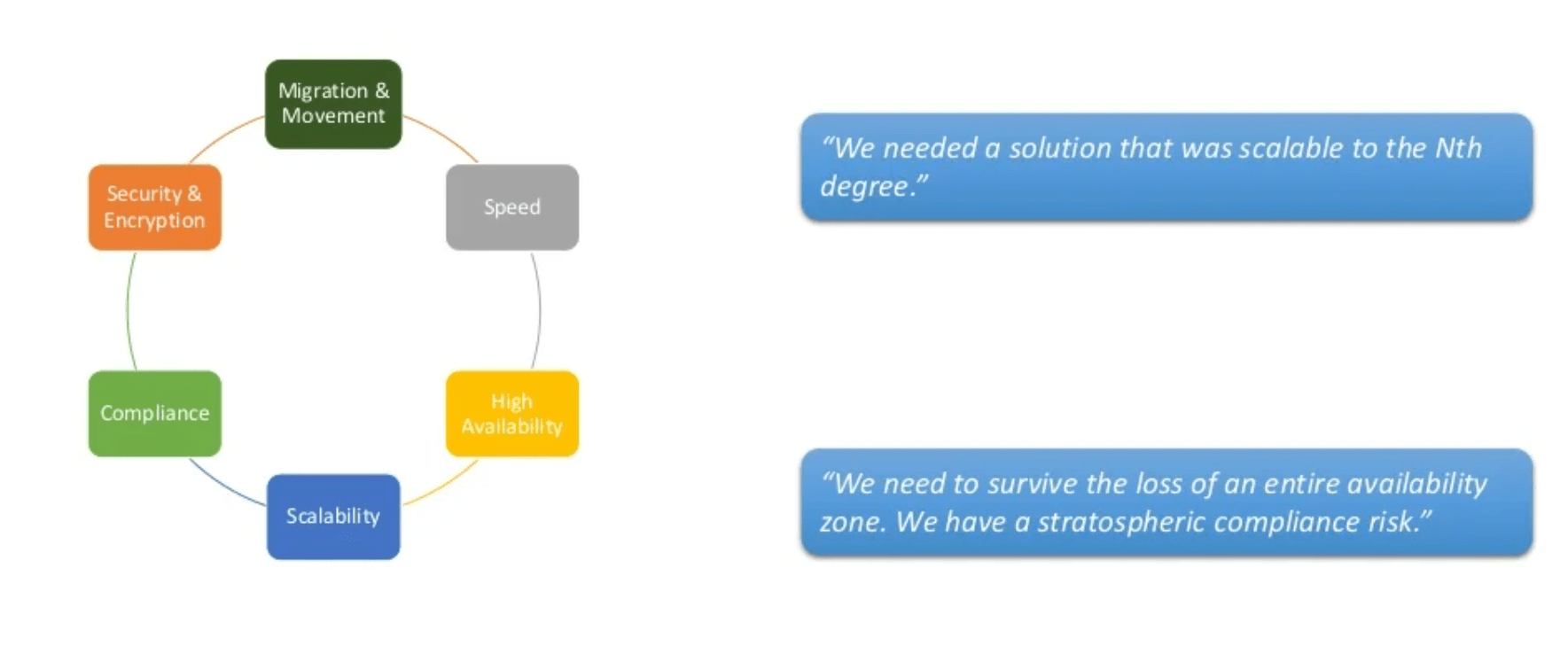
What you’ll find here with SoftNAS and what makes us very unique is that our customers continue to tell us, “By using your product, I’m able to run at the same speed or see the same customer experience in the cloud as I do on-prem.” A lot of that is because we’re able to tune our product. A lot of it is because of the way we designed our product, and more importantly, are smart people behind this that can help you make sure that your experience in the cloud is going to be the same you have on-prem with it.
Or if you’re looking for something lesser than that, we can help you with that piece here too. What you’re going to see that we’re going to be offering around migration and movement of the data, speed, performance, and high availability, which is a must, especially if you’re running any type of critical applications or even if this data has to be highly-available with it too.
You’re going to see us scalable. We can move all the way up to 16 PB. We’ve got compliance so anyone around your security pieces would be happy to hear that because we take care of the security and the encryption with the data as well to make sure it works in a seamless fashion for you.
Virtual NAS Appliance
Tune to your performance and cost requirements
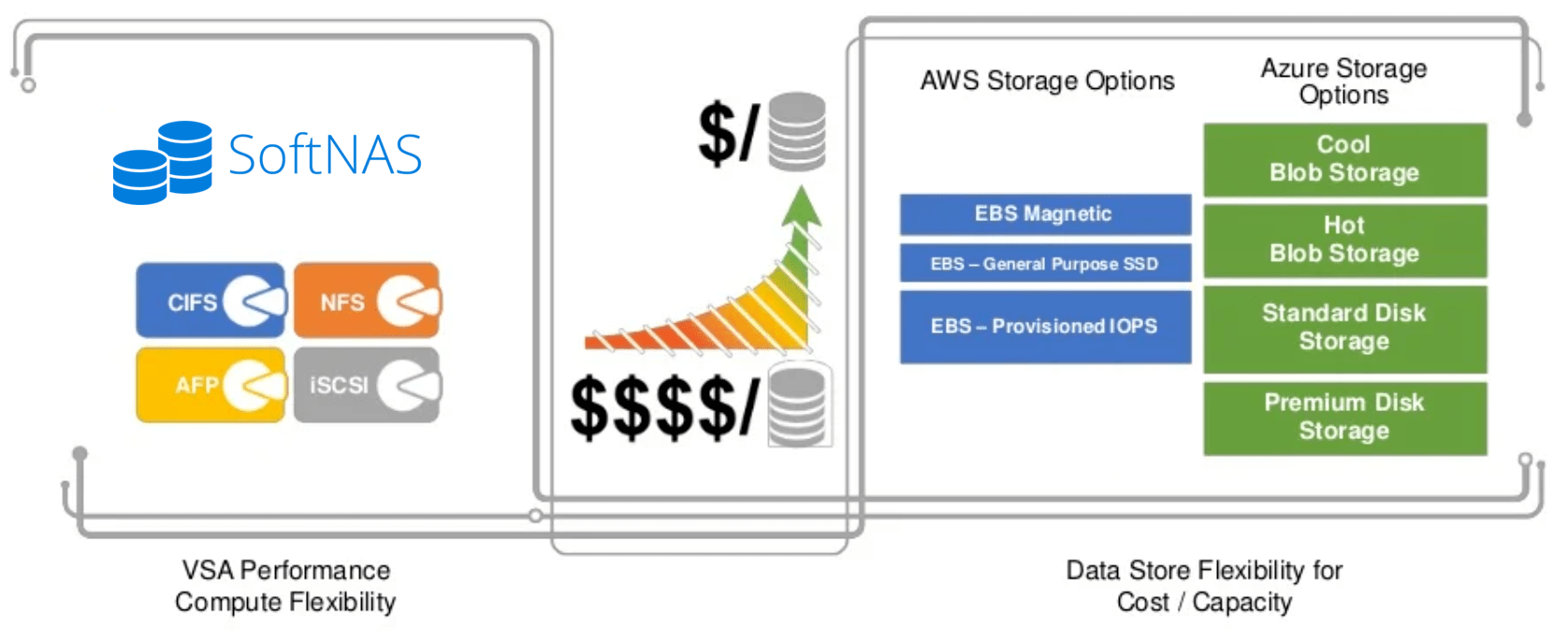
SoftNAS is a virtual NAS appliance. It’s a virtual appliance whether or not it’s in your cloud platform or if it’s sitting on-prem in your VMware environment. We are storage agnostic so we don’t care where that storage comes from. If you’re in Azure, from cool blob all the way to premium. If you are on-prem, whatever SSDs or hard drives that you have in your environment that’s connected to your VMware system, we also have the ability to do that.
As much as we are storage agnostic on the backend, on the front end, we’re also application agnostic. We don’t care what that application is. If that application is speaking general protocols such as CIFS, NFS, AFP, or iSCSI, we are going to allow you to address that storage.
And that gives you the benefit of being able to utilize backend storage without having to make API calls to that backend storage. It helps customers move to the cloud without them having to rewrite their application to be cloud-specific. Whether or not that’s AWS or Azure cloud. SoftNAS NAS Filer gives you that ability to have access to backend storage without the need of talking to APIs that are associated with that backed storage.
Tired Storage Accoress Multi-cloud Storage Types
Benefits that come out of utilizing SoftNAS as a frontend to your storage. Since I’ve been at this company, our customers have been asking us for one thing specific and that is can we get a tiering structure across multiple storage types?

This is regardless of my backend storage. I want my data to move as needed. We’re going at multiple environments and what we see for multiple environments is that probably about 10% to 20% of that data is considered hot data, with 90 to 80% of it being cool if not cold data.
Customers knowing their data lifecycle, allows them to eventually save money on their deployment. We have customers that come in and they say that “My data lifecycle is the first 30 to 60 days, it’s heavily hit. In the next 60 to 90 days, somebody will touch it or not touch it. Then the next 90 to 120 days, it needs to move to some type of archive care.” SoftNAS gives you the ability to do that by setting up smart tiers within that environment. Due to the aging policy associated with the blocks of data, it migrates that data down by tier as need be.
If you’re going through the process, after your first 30 to 60 days, the aging policy will move you down to tier two. If afterward that data is still not touched after 90 to 120 days, it will move you down to an archive tier, giving you the cost savings that are associated with being in that archive tier or being in that lower-cost tier two storage.
The benefit also is that, as much as you could migrate down these tiers, you could migrate back up these tiers. So you get into a scenario where you’re going through a review, and this is data that has not been touched for a year. However, you’re in the process of going through a review.
Whether it’s a tax review or it’s some other type of audit, what will happen is that as that data continues to be touched, it will first migrate. It will move from tier three back up to tier two. If that data continues to be touched, it will move back all the way up to tier one and it will start that live policy going all the way back down.
Your tier three could be multiple things. It could be object storage. It could be EBS magnetic or cold HDDs. Your tier, depending on the platform that you’re on, it could be EBS throughput optimized, GP2 magnetic, and vice versa.
Your hot tier could be GP2 provisioned IOPS, premium disk, or standard disk – it depends to what your performance needs would be.
High Availability (HA) Architecture
SoftNAS has patented high availability (HA) on all platforms that we support. Our HA is patented on VMware, it’s patented within Azure and also within AWS.
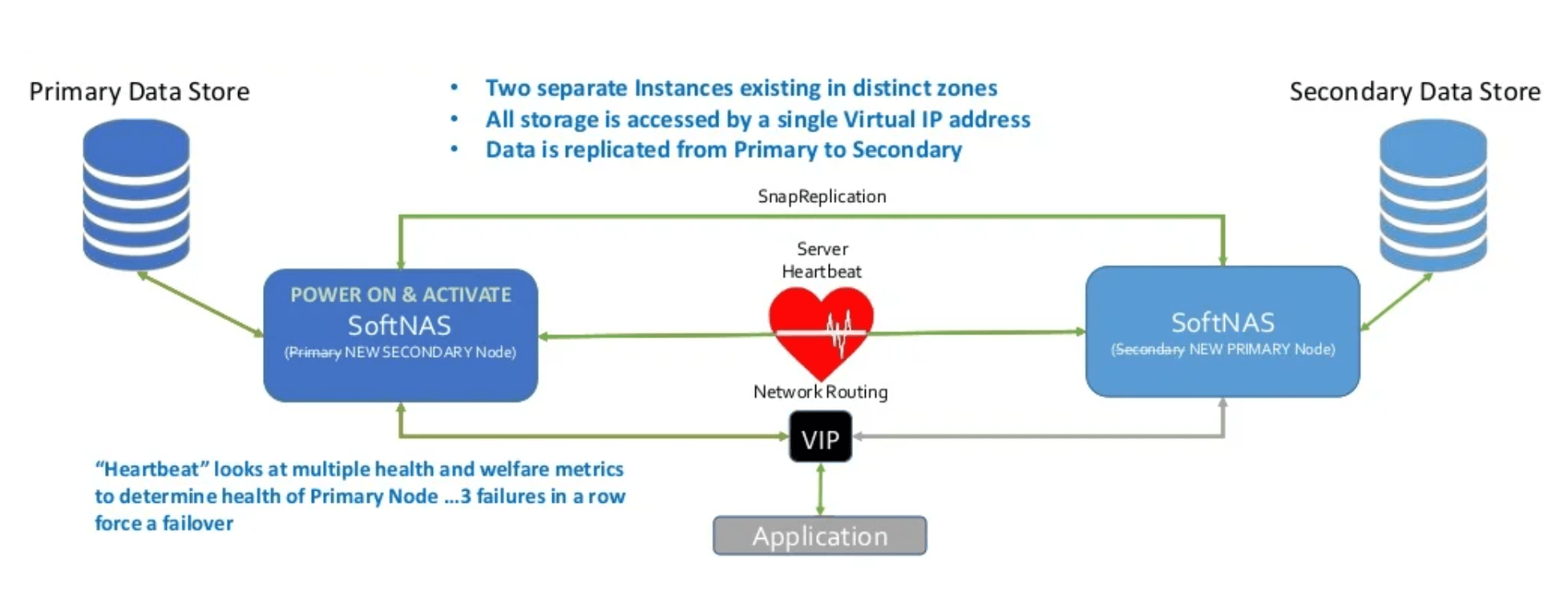
What happens within that that environment is that there is a virtual IP that sits between two SoftNAS instances. The two SoftNAS instances have their data stores that are associated with the instance.
There is a heartbeat that goes between those two instances; the application is talking to the virtual IP between them. If there is an issue or a failure that occurs, what will happen is that your primary instance will shut down and that data will be moved to your secondary instance which is now turned back to your primary instance.
The benefit of that is that it’s a seamless transition for any kind of outage that you might have within your environment.
It’s also structured with AWS best practice, so that’s to have those instances be placed in an availability set or within different availability zones so that you have the ability to utilize the SLAs that are associated with the provider.
SoftNAS Disaster Recovery (DR) and High Availability (HA)

In this scenario, we have your HA setup and your HA setup is within the California region. Within the California region, you have the system set up SnapReplication and HA because that’s what’s needed within that region.
It allows you to go ahead and do failover in case there is any issue that happens to an instance itself. In utilizing the Azure environment by you having it within an availability set, what happens is that neither one of those instances will exist on the same hardware or the same infrastructure and it will allow you to do five 9s work of durability.
Within AWS, it’s structured so that you can actually do that by using the availability zone. By using availability zones, it gives you application durability and it is up to five 9s there, also within AWS. Up until a year ago, you could say that an availability zone or a region had never gone down for any one of the providers. But about a year ago and about a month apart from each other, AWS had a region go down and Azure also had a region go down. A customer came to us and asked for a solution around that.
The solution that we gave them was DR to a region that’s outside of that availability zone or that region altogether. That’s what it shows in this next picture. It’s that although you have SmapReplicate within that region, to be able to protect you, you also have DR replication that is centered entirely outside the zone to ensure that your data is protected in case a whole region fails.
Automated Live Data Migration with continuous sync
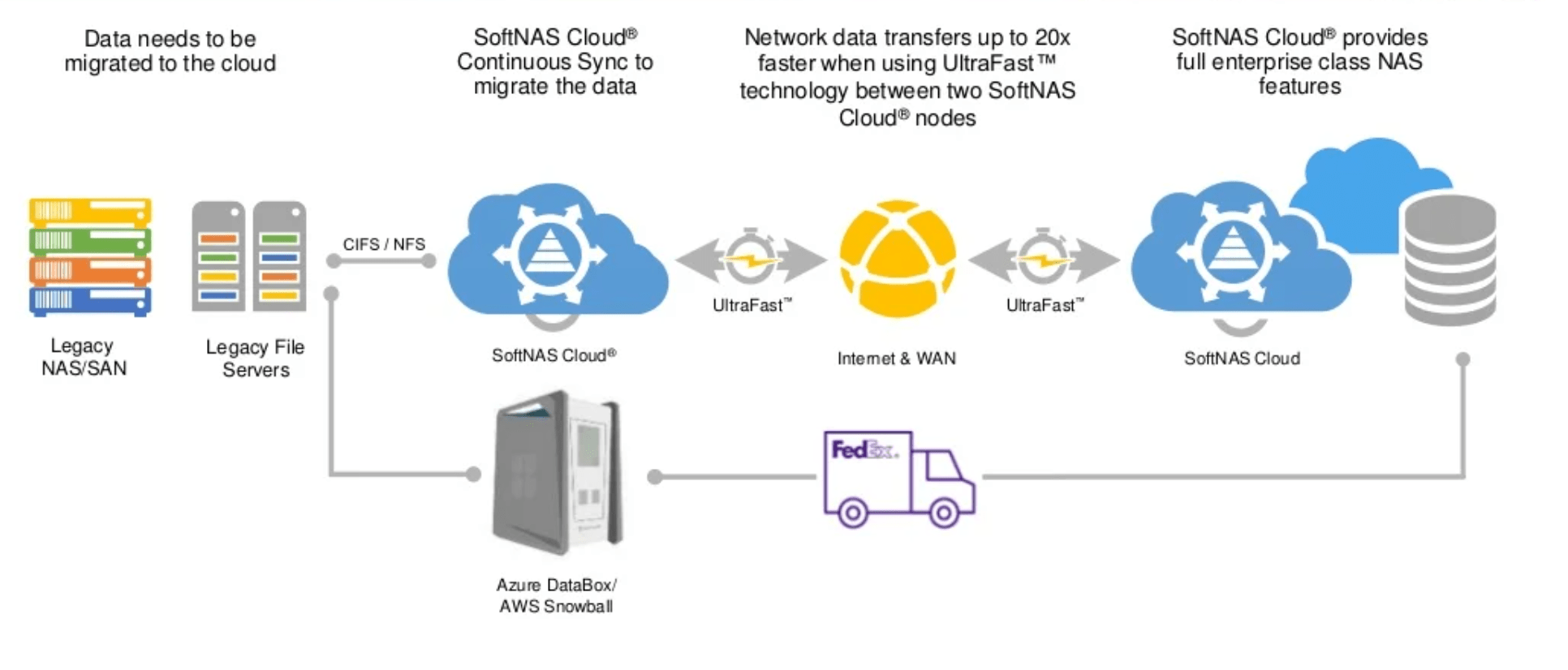
The other thing that our customers have been asking for, as we come to their environments, they have tons of data. The goal is to move to the cloud. The goal is to move to the cloud either as quickly as possible or as seamlessly as possible.
They’ve asked us for multiple solutions to help them to get that data to the cloud. If your goal is to move your data as quickly as possible to the cloud — and we’re talking about Petabytes, hundreds of Terabytes of data — your best approach at that particular point in time is taking the FedEx route.
Whether it’s Azure Data Box or AWS Snowball, being able to utilize that to be able to send the data over to the cloud and then import that data into SoftNAS makes it easier for you to be able to manage the data.
That is going to be across cut, over. That means that at some point in time, on-prem, you’re going to have to stop that traffic and say that “This is what is considered enough. I’m going to send this over to the cloud, and then I’m going to populate and start over with my new data set in the cloud and have it run that way.”
If you’re looking for one cut-over, that’s what you’re going and we’re not talking about Petabytes worth of data. The way that we explain to customers and give customers ways of actually using it would be Lift & Shift. By you using SoftNAS and the Lift & Shift data migration capability of SoftNAS, what you could actually do is you could do a warm cut-over so data still running on your legacy storage servers is being copied over to the SoftNAS device in the cloud.
Then once that copy is complete, then you just roll over to the new instance existing in the cloud. SoftNAS has congestion algorithms that we use around UltraFAST that basically allow that data to go over highly-congested lines.
What we’ve seen within our testing and within different environments is that we could actually push data up to 20X faster by using UltraFAST across lines.
This is where it comes. You need to make that decision. Are you cold cutting that data to send it over to the cloud via Azure Data Box or Snowball, or is it a possibility for you to use Lift & Shift and do a warm cut-over to the SoftNAS device that you would have in the cloud?
SoftNAS Lift and Shift Data Migration
SoftNAS’s Cost-effective Lift and Shift data migration solution allow you to move data to the cloud for economies of scale and disaster recovery, all while reducing data storage expenses.
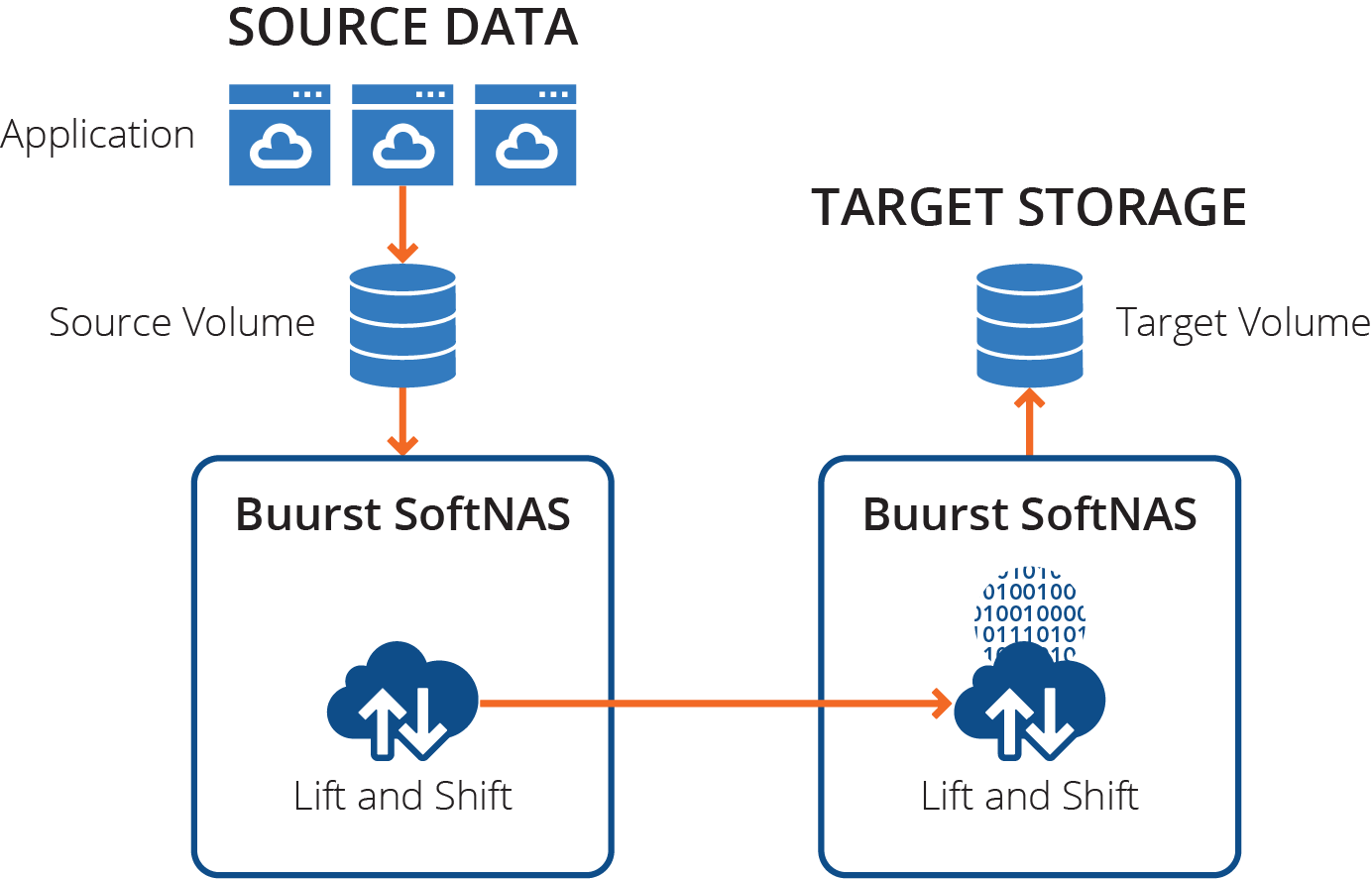
It’s a key feature of SoftNAS Cloud NAS, enabling users to migrate data from one platform to another, whether from on-premise to the cloud or between different cloud providers while maintaining continuous synchronization. SoftNAS® is a Cloud Data orchestration product, focusing on simplifying pain points within the marketplace.
As businesses continue to look for ways to increase efficiency and improve their bottom line, more and more look to the cloud. With increased flexibility, and the ability to cut out the high cost of hardware and hardware maintenance, the cloud is seen as the solution of the future, even though many are uncertain how to implement it.
Buurst hopes to make navigating the cloud a great deal easier, so that organizations can leverage the simplified business continuity strategies, and reduce infrastructure, maintenance, and service costs, without requiring advanced software and platform training.





